|

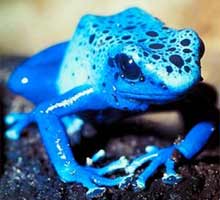
Beautiful colored skin: Poison dart frogs are popularly characterized by their brightly colored skin and small size. The skin color can range from bright orange and black to blue or yellow. However, members of the most species-rich genus, Colostethus, are generally brown. Poison dart frogs range in size from 1 centimetre (0.2 in) to 6 centimetres (2.5 in) in length, depending on the age and species of the frog.

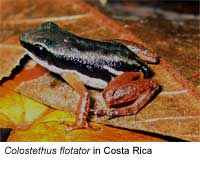 Beautiful but deadly: Poison dart frogs are a group of small, diurnal, and often brightly colored frogs native to Central and South America. These frogs received their common name from the numerous types of poisonous alkaloids found in the skin of many species. The most poisonous dart frog is the Golden Poison Dart Frog (Phyllobates terribilis). Beautiful but deadly: Poison dart frogs are a group of small, diurnal, and often brightly colored frogs native to Central and South America. These frogs received their common name from the numerous types of poisonous alkaloids found in the skin of many species. The most poisonous dart frog is the Golden Poison Dart Frog (Phyllobates terribilis).
There are well over 100 different species of poison dart frogs, only few of which are toxic 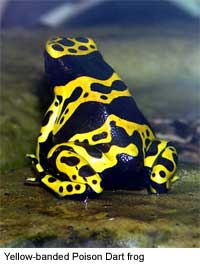 to animals and humans. More than 100 toxins have been identified in the skin secretions of poison dart frogs, especially Dendrobates and Phyllobates. Members of the genus Dendrobates (of which there are at least 44 known species) are also known as "poison dart" or "poison arrow" frogs. However, only frogs of the genus Phyllobates produce the extremely potent neurotoxin, batrachotoxin, and its derivatives. Even a very small amount of the batrachotoxin found in the skins of the Golden Poison Dart Frog and at least two other species of Phyllobates frogs - on the order of just 40 micrograms - can be fatal. For the Golden Poison Dart Frog, merely touching the frog's back with the tip of the tongue could be enough to transfer a lethal dose of poison (which is most readily absorbed via mucous membranes). to animals and humans. More than 100 toxins have been identified in the skin secretions of poison dart frogs, especially Dendrobates and Phyllobates. Members of the genus Dendrobates (of which there are at least 44 known species) are also known as "poison dart" or "poison arrow" frogs. However, only frogs of the genus Phyllobates produce the extremely potent neurotoxin, batrachotoxin, and its derivatives. Even a very small amount of the batrachotoxin found in the skins of the Golden Poison Dart Frog and at least two other species of Phyllobates frogs - on the order of just 40 micrograms - can be fatal. For the Golden Poison Dart Frog, merely touching the frog's back with the tip of the tongue could be enough to transfer a lethal dose of poison (which is most readily absorbed via mucous membranes).
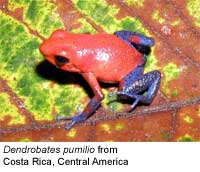 Certain tribes in South America, such as the Noanamá Chocó and Emberá Chocó indians of western Colombia, dip the tips of their blowgun darts in the poison found on the skin of three species of Phyllobates. In north Chocó, Phyllobates aurotaenia is used while to the south, in the departments of Risaralda and Choco, P. bicolor is used. In Cauca, even southern Cauca, P. terribilis is used for dart making. (Despite sometimes being called "poison arrow frogs" no examples are known of arrows, as opposed to darts, being poisoned with Phyllobates poison). No other species are used for this purpose. The poison is generally collected by roasting the frogs over a fire, but the toxins in P. terribilis are so strong that it is sufficient to dip the dart in the back of the frog without killing it. Certain tribes in South America, such as the Noanamá Chocó and Emberá Chocó indians of western Colombia, dip the tips of their blowgun darts in the poison found on the skin of three species of Phyllobates. In north Chocó, Phyllobates aurotaenia is used while to the south, in the departments of Risaralda and Choco, P. bicolor is used. In Cauca, even southern Cauca, P. terribilis is used for dart making. (Despite sometimes being called "poison arrow frogs" no examples are known of arrows, as opposed to darts, being poisoned with Phyllobates poison). No other species are used for this purpose. The poison is generally collected by roasting the frogs over a fire, but the toxins in P. terribilis are so strong that it is sufficient to dip the dart in the back of the frog without killing it.
Highly effective toxins: When a wild animal is shot with a poison-tipped dart, it will die within minutes from the neurotoxin, making additional shots unnecessary to kill it. Poison darts made from either fresh or fermented batrachotoxin are enough to drop monkeys and birds in their tracks since nerve paralysis is almost instantaneous.
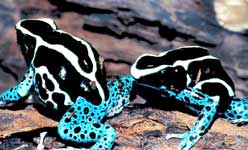 No toxic insects, no toxic frogs: There is considerable evidence that toxicity in hese frogs is derived from their diet: primarily ants, mites, and beetles. These toxins are passed from the arthropod to the frog, then sequestered in glands on the amphibian's skin. Frogs brought from the wild into captivity and fed a regular captive diet, usually fruit flies or pin-head (hatchling) crickets, eventually lose their toxicity. No toxic insects, no toxic frogs: There is considerable evidence that toxicity in hese frogs is derived from their diet: primarily ants, mites, and beetles. These toxins are passed from the arthropod to the frog, then sequestered in glands on the amphibian's skin. Frogs brought from the wild into captivity and fed a regular captive diet, usually fruit flies or pin-head (hatchling) crickets, eventually lose their toxicity.
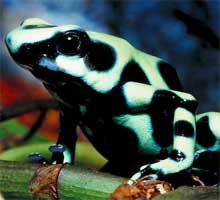
Vile smells for defense: Species of the genus Aromobates has evolved another type of chemical defense: it is not toxic, but when frightened it secretes a sticky mucus which has an extremely vile odor suggestive of skunk sprayings which repels mammalian predators. The vernacular name "Skunk Frog" of the single species Aromobates nocturnus derives from this peculiar behavior.
All text is available under the terms
of the GNU Free Documentation License
|